How to Play German Solo |
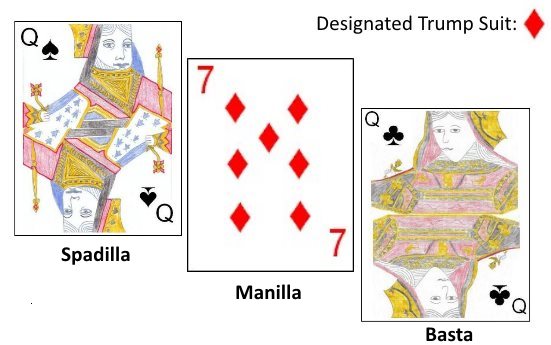 As mentioned the ranking of the cards is partially dependent on which suit is the trump suit for the hand. In this game the Queen of Clubs (called Spadilla) is always considered a member of the trump suit and as such, considered the highest card in the trump suit (whatever the trump suit is set as for the hand). Similarly, the Queen of Spades is also always considered the third highest card in the trump suit of the hand
(called Basta). The three highest trump cards in this game are called Matadors. Aside from these permanent trumps, the following shows the ranking of the cards based on the trump suit for the hand:
As mentioned the ranking of the cards is partially dependent on which suit is the trump suit for the hand. In this game the Queen of Clubs (called Spadilla) is always considered a member of the trump suit and as such, considered the highest card in the trump suit (whatever the trump suit is set as for the hand). Similarly, the Queen of Spades is also always considered the third highest card in the trump suit of the hand
(called Basta). The three highest trump cards in this game are called Matadors. Aside from these permanent trumps, the following shows the ranking of the cards based on the trump suit for the hand:
| Bid Name | Description | Point Value of Bid |
|---|---|---|
| Frog in Suit | Bid to play the hand using any suit of the players choice except Clubs as the trump suit. If this becomes the winning bid this player is entitled to call out for a high card he lacks from his hand (usually an Ace or King). The player who has the called card becomes the players partner but does not acknowledge this, with the identity of the partner only becoming known when the called card is played. This bid obligates the player to win at least 5 tricks during the hand. | 2 |
| Frog in Color | | 4 | |
| Solo in Suit | Bid to play the hand using any suit of the bidder's choice as the trump suit, with the exception of Clubs. A player playing Solo plays alone against his three opponents. This bid requires the player to win 5 or more tricks during the hand. | 4 |
| Solo in Color | Bid to play the hand using Clubs as the trump suit. A player playing this bid plays against his three opponents. This bid obligates the bidder to win a minimum of 5 tricks during the hand. | 8 |
| Tout in Suit | Player bids to play the game with no partner, winning every trick. He may set any suit as trump except Clubs. | 16 |
| Tout in Color | Bid to play the hand using Clubs as the trump suit and winning every trick with no partner. | 32 |
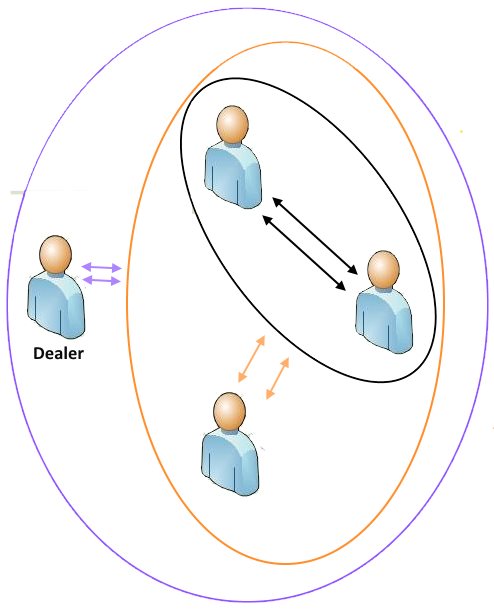 If a player makes a bid and the opponent to his left makes a higher bid, the player who made the original bid may call "Hold". This indicates he agrees to match the bid just made by that opponent. If he does not call "Hold" he is considered to have Passed, and the bidding passes to the next player to the last bidder's immediate left. If the player does declare "Hold" the higher bidder must either make a higher bid or pass himself. Eventually, one of these two players will elect to pass, with the other player currently considered to be the high bidder. The bidding then moves to the next player in clockwise rotation who has not yet made a bid during this hand. This bidding continues until all players have had an opportunity to bid or pass. The player who made the last highest bid is considered the Soloist for the hand.
If a player makes a bid and the opponent to his left makes a higher bid, the player who made the original bid may call "Hold". This indicates he agrees to match the bid just made by that opponent. If he does not call "Hold" he is considered to have Passed, and the bidding passes to the next player to the last bidder's immediate left. If the player does declare "Hold" the higher bidder must either make a higher bid or pass himself. Eventually, one of these two players will elect to pass, with the other player currently considered to be the high bidder. The bidding then moves to the next player in clockwise rotation who has not yet made a bid during this hand. This bidding continues until all players have had an opportunity to bid or pass. The player who made the last highest bid is considered the Soloist for the hand.
| Bid | Description | Point Value of Bid |
|---|---|---|
| Entrada | Highest bidder selects the trump suit of choice and is allowed to discard and draw replacement cards from the stock. | 5 |
| Vuelta | Trump is determined by revealing the top card of the stock. Highest bidder is permitted to discard and draw replacement cards from the stock. | 7 |
| Solo | High bidder select the trump suit of his choice. No discards or draws are allowed by the bidder from the stock. | 15 |
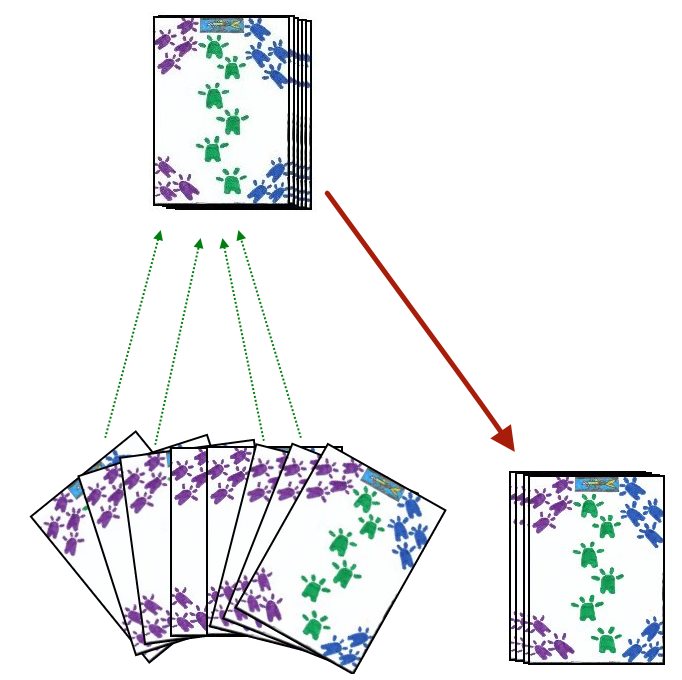 If a player has already made a bid during the current round and not passed, instead of making a higher bid than the last highest bid, may instead opt to equal that bid. Thus, the player who made the highest bid or was the last to equal the last high bid becomes the high bidder, called Ombre for the hand. Depending on the specific bid, this player has certain privileges during the hand. If the high bid was Entrada or Vuelta, the bidder is the first player allowed to make a card exchange. He may thus discard up to eight cards from his hand and draw a replacement number from the stock. He is not obligated to draw any cards from the stock if he prefers not to. For a bid of Entrada, he does this immediately after declaring the trump suit to be used for the hand. If the high bid was Vuelta he exposes the top card of the stock to determine the trump suit for the hand but may not discard or draw any cards from the stock. After the Ombre has declared the trump suit for the hand (as appropriate) and exchanged cards (when allowed), the opponents are then also entitled to each discard up to eight cards from his own hand, drawing an equal number from the stock. The two opponents of Ombre may decide amongst themselves in which order this draw may be made, but they may never discuss the actual hands they have in any manner. If less then eight cards remain for the last player to draw, he may exchange as many as are up to what is left in the deck. Any cards left undrawn are set aside and unseen for the remainder of the hand.
If a player has already made a bid during the current round and not passed, instead of making a higher bid than the last highest bid, may instead opt to equal that bid. Thus, the player who made the highest bid or was the last to equal the last high bid becomes the high bidder, called Ombre for the hand. Depending on the specific bid, this player has certain privileges during the hand. If the high bid was Entrada or Vuelta, the bidder is the first player allowed to make a card exchange. He may thus discard up to eight cards from his hand and draw a replacement number from the stock. He is not obligated to draw any cards from the stock if he prefers not to. For a bid of Entrada, he does this immediately after declaring the trump suit to be used for the hand. If the high bid was Vuelta he exposes the top card of the stock to determine the trump suit for the hand but may not discard or draw any cards from the stock. After the Ombre has declared the trump suit for the hand (as appropriate) and exchanged cards (when allowed), the opponents are then also entitled to each discard up to eight cards from his own hand, drawing an equal number from the stock. The two opponents of Ombre may decide amongst themselves in which order this draw may be made, but they may never discuss the actual hands they have in any manner. If less then eight cards remain for the last player to draw, he may exchange as many as are up to what is left in the deck. Any cards left undrawn are set aside and unseen for the remainder of the hand.
| Bid | Description | Point Value |
|---|---|---|
| Ask Leave (Alliance) | This is the lowest bid which can be made during a hand. It is a bid to win a minimum of six tricks during the hand and have the opportunity to play with a partner. He does this by calling out a specific King or Queen he does not have in his hand. Whichever player has this card becomes his partner but does not announce this, with it only becoming apparent once the called card is played to a trick. The bidder also may select any suit of his choice as trump for the hand. | 5 |
| Solo | This is also a bid to win a minimum of six tricks but playing solo with no partner. The bidder may select any trump suit to be used during the hand. The first player, on his turn, to make this bid immediately becomes the bidder and names the trump suit to be used for the hand. | 7 |
| Vole | This is a contract to win all 10 tricks during the hand. This bid is rarely used during the actual bidding phase, as most players will bid the Solo, and then during the hand opt to continue for the Vole (see below). | 10 |
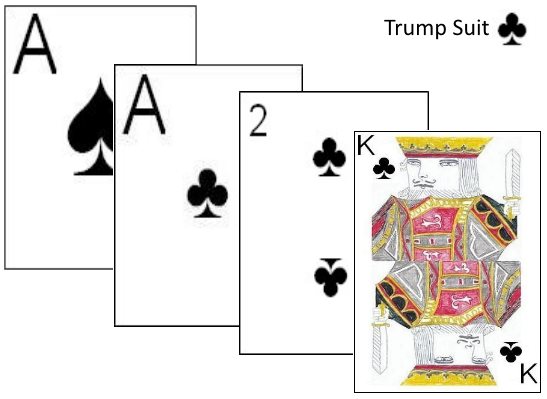
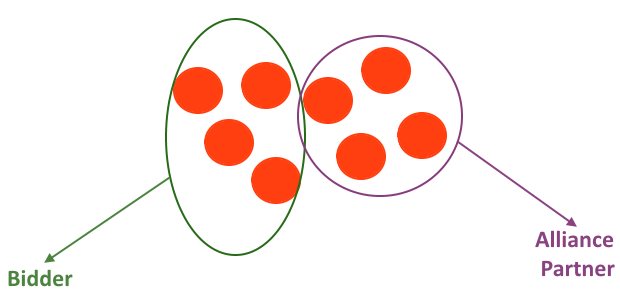 In the case of an Alliance bid and the High Bidder and the Alliance Partner manage to win the hand, the High Bidder and the Alliance Partner each collect half of the chips from the center. If these chips do not divide evenly amongst the players, any odd chips are left in the center for the next deal. In addition, these players are entitled to split the bonus points earned for the following conditions:
In the case of an Alliance bid and the High Bidder and the Alliance Partner manage to win the hand, the High Bidder and the Alliance Partner each collect half of the chips from the center. If these chips do not divide evenly amongst the players, any odd chips are left in the center for the next deal. In addition, these players are entitled to split the bonus points earned for the following conditions:
|